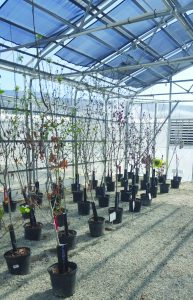By Holly Huffman

Silhouetted by the midday sun, a South Central Indiana REMC vegetation management crew trims a tree. Photo by Holly Huffman.
One thing’s for certain if your power goes out: you’ll be playing the “blame game.” What caused the outage? Storms or high winds are the usual suspects. Others might blame those cute little squirrels or other furry friends that seem to make their way atop power poles.
Storms, wind and little critters do, indeed, cause our lights to flicker or go out from time to time. However, most power outages can be attributed to a culprit you may not be considering: trees that shed limbs, dead and decaying trees that can fall on power lines and interrupt service, and trees that grow into power lines.
That’s why many cooperatives are focusing on vegetation management to reduce power outage risk and improve system reliability. This strategy can ultimately save considerable money for consumers like you.
Through vegetation management, trees and other foliage that could cause service interruptions or outages, as well as undergrowth in and around rights-of-way, are identified and cleared. “It’s very important that we trim trees back, or remove dangerous trees, so that we can provide reliable service to our members,” said Brandon Hutton, vegetation department manager at South Central Indiana (SCI) REMC. The Martinsville-based co-op has gone above and beyond to ensure its acclaimed vegetation management program benefits the consumer, the cooperative and area wildlife.
Vegetation management processes vary

Tree saplings stand ready for planting in SCI REMC’s greenhouse. Photo by Brandon Hutton.
There is no standard among cooperatives regarding vegetation management, Hutton said. Each electric cooperative is dedicated to safety and reliability, and each has its own process for dealing with vegetation. But in 2004, SCI REMC management made a decision that put the co-op at the forefront in this area.
The cooperative had traditionally used contractors to help with its vegetation management efforts. But with an eye toward cost savings and an even more far-reaching environmental impact, management decided to hire an in-house vegetation management team.
Since then, SCI REMC’s vegetation management department has grown to over 40 employees. By the end the year, six more staffers are expected to join the department. Hutton explained that staffing level is vital to ensuring system reliability is maintained. “We feel it’s the right thing to do for our members and for our cooperative,” he said.
As the largest cooperative in the state — with over 28,000 members and with a service territory spanning seven counties of rural and heavily wooded areas — vegetation management is key to keeping the co-op’s system running smoothly and power flowing reliably to homes, businesses and farms. Hutton’s crew maintains and removes unwanted vegetation from some 3,542 miles of line.
An effective vegetation management strategy starts with a knowledgeable staff. Five certified arborists who are trained in the art and science of planting, caring for, and maintaining individual trees are on SCI REMC’s staff. Three of those arborists are certified utility arborists and two are tree risk assessors certified through the International Society of Arboriculture. Arborists can quickly spot trees that are dead or decaying and can pinpoint the most beneficial way to trim or remove trees which interfere with the flow of electricity.
“Keeping our rights-of-way clear of vegetation helps our whole system run on a more reliable basis…” — Brandon Hutton
In addition to on-staff arborists, the cooperative has 10 employees with varying certifications for herbicide applications. Hutton himself has a specialized application certification which allows him to spray around waterways such as lakes and ponds.
While trees are a top concern for the vegetation management department, team members also tackle other vegetation (including shrubs, overgrown brush, etc.) from around the cooperative’s rights-of-way. That includes removing growth from under and around power lines and underneath distribution equipment and lines.
“Keeping our rights-of-way clear of vegetation helps our whole system run on a more reliable basis,” Hutton said. “It also helps provide access to equipment and lines for our line crews during power outages or routine maintenance.”
Focused on the environment

A nesting platform sits at the edge of a lake. Photo courtesy of SCI REMC.
Trimming or removing trees and clearing vegetation are not taken lightly. The crews are focused on minimizing any possible effects their work could have on members or the environment. The cooperative uses environmentally friendly herbicide and trains its vegetation management crews on the best practices for trimming and removing trees. Trees and tree limbs that are removed when rights-of-way are cleared are then processed into wood chips which are available for member use.
In keeping with its environmentally friendly mission, the cooperative reseeds cleared rights-of-way with a seed mixture which deters erosion, promotes desirable and manageable rights-of-way and fosters a healthy habitat of wildlife such as squirrels, bats, woodpeckers, and deer. In 2015, SCI REMC went a step further and enhanced its wildlife seed mixture to benefit pollinators such as bees.
From April through October, the cooperative houses tree saplings, part of its tree replacement program, in a greenhouse on the REMC’s grounds. If members allow the REMC to remove larger, fast-growing species around its rights-of-way, they may qualify for a replacement tree. (The final decision on who will receive a tree is made by vegetation department supervisors.) Replacement trees are species that are low and slow-growing and won’t be a hindrance to power lines. “This is just another way that we can give back to our members, especially since we’re asking members to remove trees,” said Hutton.
The vegetation management team also oversees the cooperative’s Wildlife Enhancement Program which creates, promotes and preserves wildlife habitats for bats, bluebirds, eagles, ospreys, hawks, and owls and other species. In 2009, staff members developed an internationally recognized Raptor Enhancement Program. To date, Hutton’s team has installed seven raptor perches throughout its service territory.
“Environmental stewardship is very important to our cooperative. It’s also important to our members,” Hutton said. “We’re proud to offer these programs as a way to give back to nature and to the environment.”
HOLLY HUFFMAN is senior communication specialist for Indiana Electric Cooperatives/Electric Consumer.



